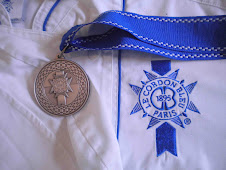This lesson is all about fish 'a la plancha', with a méli-mélo de condiments (medley of condiments... dangerous, that could be anything!), a classic cuisine dish of sautéed veal grenadin with polenta and a stuffed artichoke and finally a puff pastry dish with all kinds of berries.
'A la plancha' means 'on the griddle', one of those FLAT grill plates. If you don't have that, just pan-fry the fish. And a trick chef did with this dish was to make thin slices of rhubarb using a mandolin, then blanch it in a 30 Baum syrup and then dry them in the oven at 90degC for a while. Candied lemon zest is also made in a syrup. Quite a few starters and desserts are made with these kind of techniques. Sometimes we even use the syrups in a main dish to candy lemon or lime zest.
Let me explain a bit about the syrup: 30 Baum syrup is a solution of 1.3 kg of sugar that has been dissolved in one liter of water. 18 Baum syrup is 700 grams of sugar per liter of water. It's all about the sweetness of the syrup you are looking for and the density of the sugar to make that.
The trick with the veal grenadin was to serve it pink, not red (undercooked), not brown (overcooked), but just pink. Mine was cooked to perfection as chef Bruno S. told me in the practical. I was really happy with that result! He even got others over to have a look at my dish. Yes, I did well... We served it with polenta; That's an easy one - you can shape that in every form you can imagine; French fries 'pont-neuf' style, flat, rounds, squares, even the shape of the Eiffel Tower...
Before I forget, a 'grenadin' is the same as a tournedos of beef (tenderloin). Because this is veal, it's called a grenadin. It's the name of the veal-cut.
My notes: Here are some details of the notes I make during a demo. Sorry that the pictures are not so good ! The first picture is the list of ingredients we receive, then it's all explained in the demo and the last two pictures are my notes. It's in 3 languages, all mixed up and messy... but at least I can read and reproduce it!
(click on the pictures for a 'blow-up')
Tomorrow, it's our atelier.....
See you all later!
Sjoerd
PS: the wines, how could I forget - with the starter we serve a Mediterranian wine, something like a rosé 'Ott', or something Spanish like Muscat d'Alexandria. With the main course we could serve a cabernet sauvignon, like Bouguoi from the Loire Valley. Don't serve a pinot noir or merlot. It's an acidic sauce with plain polenta. Medoc can be chosen. For dessert a sweet dessert wine, but when we have whipped cream, strawberries, we always go for....... ta,taaaaaa.... champagne!
We could even serve a creme de framboise or a Muscat wine from the Rhone valley with it. (This last one is tres parfumée and sticky.)





Let me explain a bit about the syrup: 30 Baum syrup is a solution of 1.3 kg of sugar that has been dissolved in one liter of water. 18 Baum syrup is 700 grams of sugar per liter of water. It's all about the sweetness of the syrup you are looking for and the density of the sugar to make that.
ReplyDeleteweb design canada ,
wordpress developer vancouver ,